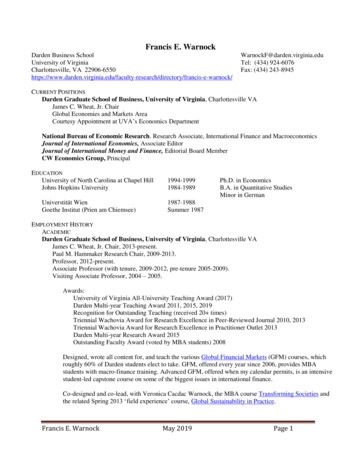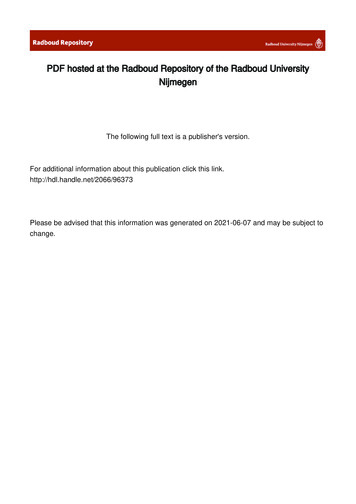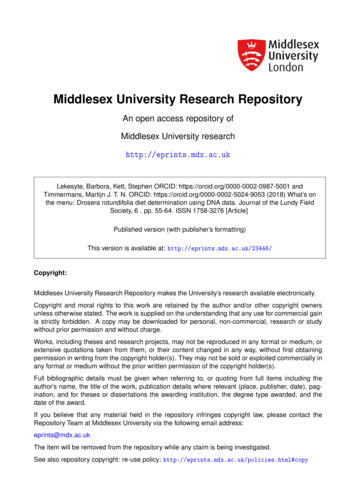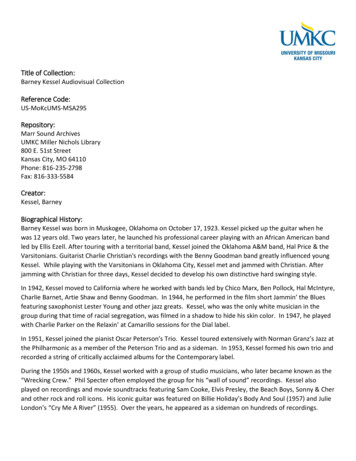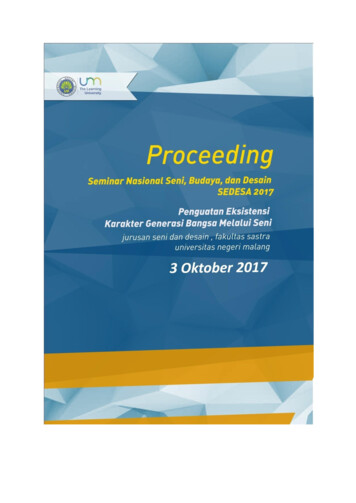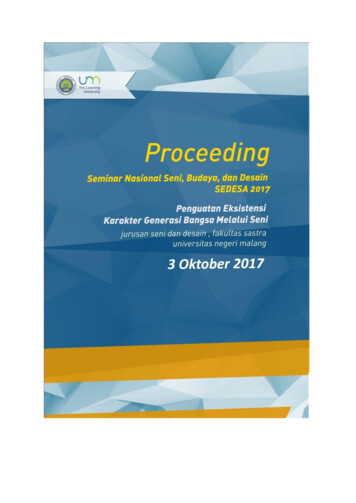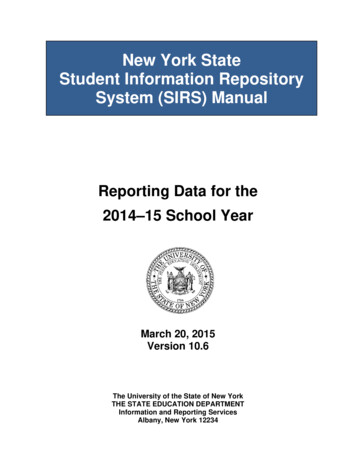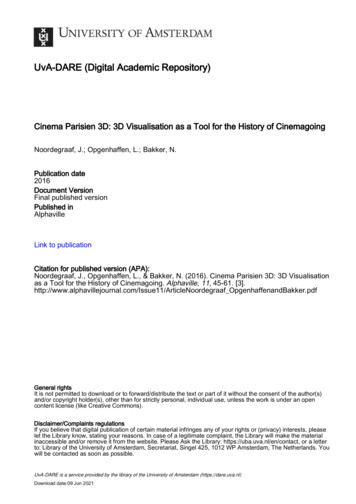
Transcription
UvA-DARE (Digital Academic Repository)Cinema Parisien 3D: 3D Visualisation as a Tool for the History of CinemagoingNoordegraaf, J.; Opgenhaffen, L.; Bakker, N.Publication date2016Document VersionFinal published versionPublished inAlphavilleLink to publicationCitation for published version (APA):Noordegraaf, J., Opgenhaffen, L., & Bakker, N. (2016). Cinema Parisien 3D: 3D Visualisationas a Tool for the History of Cinemagoing. Alphaville, 11, 45-61. leNoordegraaf OpgenhaffenandBakker.pdfGeneral rightsIt is not permitted to download or to forward/distribute the text or part of it without the consent of the author(s)and/or copyright holder(s), other than for strictly personal, individual use, unless the work is under an opencontent license (like Creative Commons).Disclaimer/Complaints regulationsIf you believe that digital publication of certain material infringes any of your rights or (privacy) interests, pleaselet the Library know, stating your reasons. In case of a legitimate complaint, the Library will make the materialinaccessible and/or remove it from the website. Please Ask the Library: https://uba.uva.nl/en/contact, or a letterto: Library of the University of Amsterdam, Secretariat, Singel 425, 1012 WP Amsterdam, The Netherlands. Youwill be contacted as soon as possible.UvA-DARE is a service provided by the library of the University of Amsterdam (https://dare.uva.nl)Download date:09 Jun 2021
Cinema Parisien 3D: 3D Visualisation as a Tool for the History of CinemagoingJulia Noordegraaf, Loes Opgenhaffen, and Norbert Bakker, University of AmsterdamAbstract: In this article we evaluate the relevance of 3D visualisation as a research tool for the history ofcinemagoing. How does the process of building a 3D model of cinema theatres relate to what we already knowabout this history? In which ways does the modelling process allow for the synthesis of different types ofarchived cinema heritage assets? To what extent does this presentation of “content in context” helps us to betterunderstand the history of film consumption? We will address these questions via a discussion of a specific casestudy, our visualisation of Jean Desmet’s Amsterdam Cinema Parisien theatre, one of the first permanentcinemas of the Dutch capital. First, we reflect on 3D as a research tool, outlining its technology andmethodological principles and its usefulness for research into the historiography of moviegoing. Then wedescribe our 3D visualisation of Cinema Parisien, discussing the process of researching and building the model.Finally, we evaluate the result against the existing knowledge about the history of cinemagoing in Amsterdamand of this cinema theatre in particular, and answer the question to what extent 3D as a research tool can aidour understanding of the history of cinema consumption.IntroductionOn 26 March 1910, the Netherlands-based cinema pioneer Jean Desmet (1875–1956)opened Cinema Parisien, his first permanent film theatre in Amsterdam. Building upon thesuccess of the theatre that he had opened under the same name in Rotterdam the year before,with the establishment of the Amsterdam Parisien Desmet initiated the institution ofpermanent cinema theatres in the capital. The theatre remained functional at Nieuwendijk 69until 1987, having been used since the Second World War also as an adult movie theatre.1The cinema’s 1924 art-deco interior was installed in one of the rooms at the NetherlandsFilmmuseum at Vondelpark in the early 1990s and can be admired today in a recently openedcinema complex at De Hallen, a cultural centre in a converted industrial building in thewestern part of Amsterdam. The history of the Amsterdam Cinema Parisien is welldocumented, in particular because, besides a collection of over 900 films from the 1910s, andone of film posters and photographs, Desmet left behind a vast business archive that uniquelydocuments the early period of Dutch cinema industry and culture.2Recently, in the context of the “Images of the Future” digitisation programme, theentire Desmet Collection has been digitised by the EYE Film Institute Netherlands. Theavailability of the collection in digital form opens new opportunities for investigating thehistory of early cinema in the Netherlands. As part of the research project “CreativeAmsterdam: An E-Humanities Perspective”, the authors investigated the opportunitiesafforded by 3D visualisation as a tool for studying the role and place of cinema theatres in theentertainment industry of early-twentieth-century urban culture.3 On the one hand, this iscompatible with a trend towards digital methods in historical research. In a recent publicationon big data in the field of historiography, Shawn Graham, Ian Milligan and Scott Weingartargue that, in an era when the sources for historical research become digitally available in“ever-increasing scales”, it is imperative for historians to be able to employ digital tools ofanalysis in their practice (24). On the other hand, our investigation into the potentialities of3D visualisation for film history contributes to answering the question of how digitisedcultural heritage collections can be utilised in the production and dissemination of academicresearch. Julia Noordegraaf, Loes Opgenhaffen, and Norbert Bakker.This work is licensed under a Creative Commons Attribution-NonCommercial-NoDerivatives 4.0 International License.
46Figure 1 (left): Cinema Parisien at Nieuwendijk 69, Amsterdam in 1976. Photograph Paul van Galen1976. Source: Cultural Heritage Agency of the Netherlands photo collection. Licence CC.BY-SA 4.0.Figure 2 (right). Jean Desmet’s membership card of the Dutch Cinema Federation. Public Domain.In this article we evaluate the relevance of 3D visualisation as a research tool for thehistory of cinemagoing. How does the process of building 3D models of cinema theatresrelates to what we already know about this history? In which ways does the modellingprocess allow for the synthesis of different types of archived cinema heritage assets? To whatextent does this presentation of “content in context” helps us to better understand the historyof film consumption? We will address these questions via a discussion of a specific casestudy, our visualisation of Desmet’s Cinema Parisien in Amsterdam. The choice of this casestudy was motivated by its historical importance as one of the first permanent cinema theatresin Amsterdam with a long, rich history that is extensively documented. First, we will reflecton 3D visualisation as a research tool, outlining its technology and methodological principlesand its usefulness for research into the historiography of cinemagoing. Subsequently, we willdescribe our 3D visualisation of Cinema Parisien, discussing the process of researching andbuilding the model. Finally, we will evaluate the results against the existing body ofknowledge on the history of cinemagoing in Amsterdam, and of this cinema theatre inparticular, and answer the question to what extent 3D visualisation as a research tool can aidour understanding of the history of cinema consumption.3D Visualisation as a Research ToolIn archaeology, 3D modelling and virtual reality already play a significant part in thereconstruction of the past. The very first 3D model was a visualisation of the Roman Bathcomplex in Bath, UK. This model was built by John Woodwark, lecturer in manufacturingengineering at Bath University, on the occasion of a 1984 BBC programme on the RomanBaths, involving Barry Cunliffe, professor of European archaeology at the University ofOxford (Woodwark 19). Soon after, the IBM UK Scientific Centre produced a number of 3Dmodels of archaeological sites, including a model of the first, Anglo-Saxon Minster inWinchester, built with IBM’s “Winchester Solid Modeler” technology (Reilly, “DataVisualisation”).4 Because of its subject matter, archaeology provided a natural showcase fortechnology-driven 3D visualisations, evidencing the attraction of recreating something that isno longer there. Although Paul Reilly coined the term “virtual archaeology” already in 1991,Alphaville: Journal of Film and Screen MediaIssue 11, Summer 2016, pp. 45–61
47foreseeing a future where techniques such as 3D modelling would support archaeologists inthe documentation of excavations (“Towards a Virtual Archaeology”), the application of 3Dvisualisation in archaeology in the 1980s and 1990s was primarily technology driven, usingthe computer models as illustrations rather than as research tools for archaeological research.The first attempts to implement 3D visualisation in the archaeological researchprocess started in the early 2000s. For example, Juan Barceló conceived of 3D visualisationas a means for simulating the archaeological process of thought (9). The fact that a 3D modelprovides an environment to conduct experiments with different parameters and outcomesmakes it highly suited for testing diverging interpretations of the same source material (see,for example, Hermon, “Scientific Method”). Bernard Frischer et al. pointed out that 3Dmodelling can represent thoughts and ideas and enable the translation of “empiricalphenomena into geometric language” (11).Frischer et al. were also among the first to be concerned about the validation not onlyof the data and methods used, but also of the models themselves. As they point out, thisvalidation can be realised through the documentation of the process of modelling and thestorage of the components of the model, accompanied by the research data anddocumentation on the decisions that underlie the creation of the model (7–9). In Nick Ryan’sview, the development of accessible interfaces with this kind of data would facilitate theidentification of uncertainties in the modelling process as well as the generation of alternativeinterpretations (246). In addition, in 2009 researchers, educators and cultural heritageorganisations laid down internationally recognised principles for the use of computer-basedvisualisation in The London Charter (Denard). This document introduced the concept of“paradata”: the creation of documentation that gives the means to record and trace thedecisions behind the modelling process and, thus, contributes to the creation of reliable,accountable models (see also Baker). With this new regard for the transparency of themodelling process, the emphasis slowly shifted from the technology itself to 3D visualisationas a research tool within archaeological discourse and, more generally, the study of socialprocesses in the past.As promising as these method-oriented questions may seem in promoting the usage of3D modelling as a “research tool to generate new knowledge” (Frischer, “From DigitalIllustration” viii), to this day their elaboration and implementation in actual research remainslimited. Fifteen years later, themes such as the “transparency of data” and the “documentationof the process of modelling” are still current (see Demetrescu). The exact scope of paradatahas not yet been defined; there are no standards regarding the level of transparency orcertainty, which may serve as a reference. Digital libraries with 3D models connected to theunderlying data are extremely rare, mostly due to time and budget constraints. Consequently,3D visualisations are often still presented traditionally, in print or in the form of a film, ratherthan as virtual environments that can be navigated by the user/viewer. The presentation of the3D model in an interactive and freely navigable environment, with connections to instantlyretrievable underlying information, is already technically possible, but generally not withinreach of the scholar. In the research project on Cinema Parisien 3D presented here, wepropose a solution for the publication of an accessible, transparent version of 3Dvisualisations.The use of 3D visualisation in the field of film studies is coherent with recent spatialorientations in film-historical scholarship, in particular the use of spatial methods “to explorethe historical geographies of film production and exhibition” (Hallam and Roberts 16). AsAlphaville: Journal of Film and Screen MediaIssue 11, Summer 2016, pp. 45–61
48Julia Hallam and Les Roberts explain, scholarship in this area “focuses on cinema as socialexperience, conditioned by factors such as transportation networks, ethnicity, and socialgroup as well as cinema architecture, ticket prices, and the changing patterns of work andleisure” (20). As Robert C. Allen has pointed out, such a comprehensive, spatial approach isnecessary for understanding how cinema was experienced “at any one point in any place inthe past” (qtd. in Hallam and Roberts 20) and, thus, how cinemagoing influenced theconstruction of social identity (Allen).Figure 3: First class ticket, Cinema Parisien. EYE Film Institute Netherlands, Desmet Archive,MMFMA01 AF 024338.Thus far, spatial film historiography has primarily employed GIS mappingtechnologies to capture the multilayered nature of cinemagoing (Hallam and Roberts).Examples of 3D visualisation of cinema theatres are very scarce and often are created foreducational purposes, such as the virtual reconstruction of Charles-Émile Reynaud’s ThéâtreOptique built by Museu del Cinema, Girona (“Pre-cinema Audio-visual Resources”).5However, when used as a research tool, adhering to the principles outlined above, 3Dvisualisation has much to offer to the spatial analysis of the history of cinemagoing.As Robert Allen noted, spatial representations of places where cinema wasexperienced tend to represent them as inert and ahistorical, exemplified by photo books ofpicture palaces (15). Employing 3D visualisation enables the evocation of the multipledimensions of cinemagoing by creating dynamic, interactive models of cinema theatres andtheir environments, which document the development of the places and their social functionsas they take place, over time. Moreover, we also consider the building of the
entire Desmet Collection has been digitised by the EYE Film Institute Netherlands. The availability of the collection in digital form opens new opportunities for investigating the history of early cinema in the Netherlands. As part of the research project “Creative Amsterdam: An E-Humanities Perspective”, the authors investigated the opportunities afforded by 3D visualisation as a tool for .


